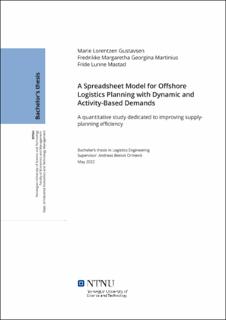| dc.contributor.advisor | Ormevik, Andreas Breivik | |
| dc.contributor.advisor | Ashrafian, Alireza | |
| dc.contributor.author | Gustavsen, Marie Lorentzen | |
| dc.contributor.author | Martinius, Fredrikke Margaretha Georgina | |
| dc.contributor.author | Mastad, Fride Lunne | |
| dc.date.accessioned | 2022-07-05T17:22:06Z | |
| dc.date.available | 2022-07-05T17:22:06Z | |
| dc.date.issued | 2022 | |
| dc.identifier | no.ntnu:inspera:112277671:112286699 | |
| dc.identifier.uri | https://hdl.handle.net/11250/3002909 | |
| dc.description.abstract | Petroleumsindustrien står ovenfor flere avgjørende valg i møte med en mer bærekraftig verden.
Ved produksjon av flere ikke-fornybare produkter, er industrien avhengig av å gjøre tiltak innenfor de ulike sektorene i næringen for å bli mer bærekraftig. Blant dem finner vi offshore logistikk.
Denne bacheloroppgaven er skrevet i samarbeid med Equinor ASA, som er en av de største aktørene i den norske petroleumsindustrien. Offshore logistikk er essensielt for at blant annet driften av offshore installasjonene fungerer slik de skal og at forsyninger blir levert til installasjonene. Denne bacheloroppgaven vil ta for seg hvordan man kan forbedre forsyningsplanlegging innenfor offshorelogistikk og effektivisere den mest mulig.
Det er flere aspekter som påvirker hvordan forsyningen til installasjonene burde utføres. Hver installasjon har sin ukentlige standard etterspørsel, hvor enkelte installasjoner også har pågående prosjekter som forandrer etterspørselen, dette fører til at etterspørselen har kontinuerlig endringer. Forsyningen og behovet for fartøy endres hver uke og en dynamisk ruteplanlegging er derfor nødvendig.
For å kunne svare på problemstillingen er det gjennomført en casestudie som ser spesifikt på en av Equinors baser, Dusavik og dens forsyninger til de ulike installasjonene. Videre er Excel brukt som et hyppig verktøy med ulike tilleggsverktøy for å kunne utarbeide en regnearkmodell som gir en dynamisk løsning på planleggingsutfordringen. Denne skal optimalt sett redusere utslipp og samtidig minimere kostnader knyttet til transporten. Regnearkmodellen er utformet på grunnlag av historiske data innhentet fra Equinor, samt basert på forhåndsgenererte ruter og den virkelige framtidsplanen til Equinor. Ulike forsyningstilnærminger er utforsket i denne regnearkmodellen for å undersøke hvor dynamisk ruteplanleggingen bør være for å få en mer optimal løsning med tanke på utnyttelsen.
Denne regnearkmodellen er utviklet på en slik måte at den gir muligheten til å foreta justeringer og modifikasjoner tilpasset egne behov og prosjekter. Med tanke på modellens raske svar og løsninger innen få minutter for hver uke, vil dette ikke bare være et nyttig verktøy for Equinor, men åpner også opp for bruk av regnearkmodellering som standardverktøy ved ruteplanlegging. | |
| dc.description.abstract | The petroleum industry encounters several choices in the face of a more sustainable world. Because of their production of several non-renewable products, the industry is dependent on taking measures within the various sectors of the industry to become more sustainable. Among them we find offshore logistics.
This bachelor thesis is written in collaboration with Equinor ASA, which is one of the largest actors in the Norwegian petroleum industry. Offshore logistics is essential for, among other things, the operation of the offshore installations and to ensure that supplies are delivered to the installations. This bachelor thesis will address how supply planning within offshore logistics can be improved to increase efficiency.
There are several aspects that affect how the supply to the installations is carried out. Each installation has its standard demand, where some installations also have ongoing projects which change their demand, leading to continuous changes in the total demand. The demand and required vessels change every week; thus, a dynamic route planning is necessary.
To be able to answer the problem statement, a case study has been carried out that specifically looks at one of Equinor's supply depots, Dusavik, and its supply to the various installations. Furthermore, Excel, with additional add-in tools, is a frequently utilized tool, used to create a spreadsheet model that provides a dynamic solution to the planning challenges. This should optimally reduce emissions while at the same time minimizing costs associated with transport. The spreadsheet model is designed on the basis of historical data obtained from Equinor, and is based on pre-generated routes, and Equinors future progress plan. Various supply approaches have been explored in this spreadsheet model to examine to which degree the route planning should be dynamic, in order to obtain a more optimal solution in terms of utilization.
This spreadsheet model has been developed in such a way that it provides the opportunity to adjust and modify to adapt to one's own needs and projects. Considering the models quick answers and weekly solutions within minutes, this will not only be a useful tool for Equinor, but also provides the opportunity for the use of spreadsheet modeling as a standard tool for route planning. | |
| dc.language | eng | |
| dc.publisher | NTNU | |
| dc.title | A Spreadsheet Model for Offshore Logistics Planning With Dynamic and Activity-Based Demands | |
| dc.type | Bachelor thesis | |
